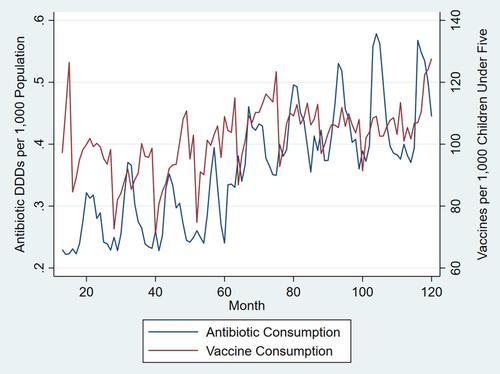当前位置:
X-MOL 学术
›
Ann. N. Y. Acad. Sci.
›
论文详情
Our official English website, www.x-mol.net, welcomes your
feedback! (Note: you will need to create a separate account there.)
Associations between private vaccine and antimicrobial consumption across Indian states, 2009–2017
Annals of the New York Academy of Sciences ( IF 4.1 ) Pub Date : 2021-02-05 , DOI: 10.1111/nyas.14571 Emily Schueller 1 , Arindam Nandi 1 , Jyoti Joshi 2, 3 , Ramanan Laxminarayan 2, 4 , Eili Y Klein 1, 5
Annals of the New York Academy of Sciences ( IF 4.1 ) Pub Date : 2021-02-05 , DOI: 10.1111/nyas.14571 Emily Schueller 1 , Arindam Nandi 1 , Jyoti Joshi 2, 3 , Ramanan Laxminarayan 2, 4 , Eili Y Klein 1, 5
Affiliation

|
Vaccines can reduce antibiotic use and, consequently, antimicrobial resistance by averting vaccine-preventable and secondary infections. We estimated the associations between private vaccine and antibiotic consumption across Indian states during 2009–2017 using monthly and annual consumption data from IQVIA and employed fixed-effects regression and the Arellano–Bond Generalized Method of Moments (GMM) model for panel data regression, which controlled for income and public sector vaccine use indicators obtained from other sources. In the annual data fixed-effects model, a 1% increase in private vaccine consumption per 1000 under-5 children was associated with a 0.22% increase in antibiotic consumption per 1000 people (P < 0.001). In the annual data GMM model, a 1% increase in private vaccine consumption per 1000 under-5 children was associated with a 0.2% increase in private antibiotic consumption (P < 0.001). In the monthly data GMM model, private vaccine consumption was negatively associated with antibiotic consumption when 32, 34, 35, and 44–47 months had elapsed after vaccine consumption, with a positive association with lags of fewer than 18 months. These results indicate vaccine-induced longer-term reductions in antibiotic use in India, similar to findings of studies from other low- and middle-income countries.
中文翻译:

2009-2017 年印度各邦私人疫苗与抗生素消费之间的关联
疫苗可以通过避免疫苗可预防的继发感染来减少抗生素的使用,从而减少抗生素耐药性。我们使用来自 IQVIA 的月度和年度消费数据估计了 2009-2017 年印度各邦私人疫苗和抗生素消费之间的关联,并采用固定效应回归和阿雷拉诺-邦德广义矩法 (GMM) 模型进行面板数据回归,其中控制从其他来源获得的收入和公共部门疫苗使用指标。在年度数据固定效应模型中,每 1000 名 5 岁以下儿童的私人疫苗消费量每增加 1%,则每 1000 人的抗生素使用量增加 0.22%(P< 0.001)。在年度数据 GMM 模型中,每 1000 名 5 岁以下儿童的私人疫苗消费量增加 1% 与私人抗生素消费量增加 0.2% 相关(P < 0.001)。在月度数据 GMM 模型中,当疫苗消费后 32、34、35 和 44-47 个月过去时,私人疫苗消费与抗生素消费呈负相关,与不到 18 个月的滞后呈正相关。这些结果表明疫苗引起的印度抗生素使用的长期减少,类似于其他低收入和中等收入国家的研究结果。
更新日期:2021-02-05
中文翻译:

2009-2017 年印度各邦私人疫苗与抗生素消费之间的关联
疫苗可以通过避免疫苗可预防的继发感染来减少抗生素的使用,从而减少抗生素耐药性。我们使用来自 IQVIA 的月度和年度消费数据估计了 2009-2017 年印度各邦私人疫苗和抗生素消费之间的关联,并采用固定效应回归和阿雷拉诺-邦德广义矩法 (GMM) 模型进行面板数据回归,其中控制从其他来源获得的收入和公共部门疫苗使用指标。在年度数据固定效应模型中,每 1000 名 5 岁以下儿童的私人疫苗消费量每增加 1%,则每 1000 人的抗生素使用量增加 0.22%(P< 0.001)。在年度数据 GMM 模型中,每 1000 名 5 岁以下儿童的私人疫苗消费量增加 1% 与私人抗生素消费量增加 0.2% 相关(P < 0.001)。在月度数据 GMM 模型中,当疫苗消费后 32、34、35 和 44-47 个月过去时,私人疫苗消费与抗生素消费呈负相关,与不到 18 个月的滞后呈正相关。这些结果表明疫苗引起的印度抗生素使用的长期减少,类似于其他低收入和中等收入国家的研究结果。











































 京公网安备 11010802027423号
京公网安备 11010802027423号